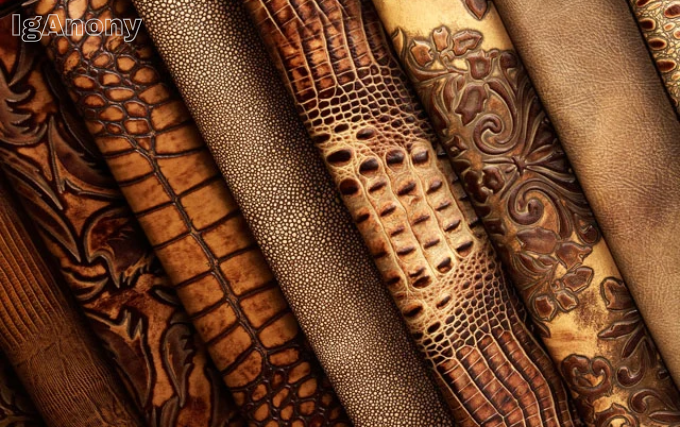The method of embossing skin is very esoteric and has grown in popularity in the leather-making and design world. By seeing to it that the patterns are raised or recessed on animal skins, they give texture, depth, and decorative appeal to leather products. Another matter still is the trade in animal skins for sale which stands as an important profession worldwide, serving as a channel that merges traditional with contemporaneous fashion and artisanal crafts.
There are two main embossing methods onto leather:
- Hot Embossing:
Elevated temperatures are used in this method to press the plates or dies onto the skin. The heat becomes responsible for the softening of the leather fibers so that the pattern can be deeply imprinted there. It is also possible under hot embossing to add colored or metallic foils, such as gold, to yet further luxuriously finish the design. - Cold Embossing:
Designs are created using pressure applied without heat. This is less invasive and is considered for use on thin or delicate skins. Cold embossing accomplices a subtler effect when compared to hot embossing.
Embossing is also subdivided into several styles:
- Blind Embossing: The imprint is made on leather without application of color or foil, resulting in a subtle tactile pattern that is in harmony with the leather’s natural color.
- Congresive Embossing: It raises the design upon the surface of the leather and often does so by means of a counter-die which renders a convex effect.
- Multilevel and Sculptured Embossing: More advanced techniques that vary the depth of embossing to create dynamic three-dimensional images and may sometimes even be hand-carved for finer effects.
Embossed Animal Skin Applications
The application of embossed skins in fashion and accessories has been very much in demand-theaters where belts, wallets, handbags, shoes, and notebooks dominate. This method allows craftsmen to customize products with logos, intricate designs, or artistic representations to increase the uniqueness and value of the leather goods.
Furthermore, embossing is an ideal gift decoration method, suitable for customizing an elegant finish onto leather gifts. The ability to emboss at home with special presses has given great room for enchantment to hobbyists and small-scale producers.
Animal Skins for Sale: Sources and Uses
Animal skins for sale were prominent in human life from the dawn of civilization, being used for clothing, upholstery, and other crafts. These days, there is still the trade in animal skins, depending on economics and cultures, with ethical concerns sometimes coming into weighing in.
Animal Skin Sources or Hide Types
Livestock and Festival Animals: Skin of animals is collected and sold in many cultures when animals are sacrificed in festivals connected with religion. In cities like Aligarh, for example, skins of goats and sheep sacrificed during Bakr Eid are collected by organizations and sold into markets to raise funds for charitable causes such as scholarships.
Wildlife and Game Animals: In some areas, skins from wild animals killed for population control or agricultural protection are admitted into the market.
Ethical Considerations
Raising ethical questions and concerns, the utilisation of animal skin does so depending on issues such as sourcing responsibly or involving sustainable hunting so that the trade does not promote the suffering of animals or environmental degradation.
Some artisans and businesses utilize skin upcycling processes whose skins are otherwise discarded in order to include skins from culled deer or skins from festival animals. It of course promotes a circular economy and avoids wastage.
The Preparation and Embossing of Animal Skins
Animal skins receive tanning treatment to preserve and soften the leather for their making. The thick-ness of the skin is an essential factor as usually, embossing mor-sels between 1.5 to 3 mm thickness.
Special equipment such as presses and dies is required in the process of embossing. Hot embossing uses heated metal stamps or plates, usually in combination with foil overlays, to apply the design. It operates without heat and thus with only pressure. Skilled artisans will adjust the pressure and temperature so as not to damage the leather, but to produce the desired effect.
Market Trends and Demand from Consumers
For embossing-skins demand is propelled by the increased appreciation of handcrafted and customized items. Consumers want rare items combining contemporary design with age-old skilled craft.
On the other hand, factors such as the animal welfare and environmental consciousness enter into the purchasing decision. A brand or artist concerned with ethical sourcing and sustainability should attract customers.
Conclusion
Skin embossing is an intricate, versatile process of the greatest artists able to enhance animal skins in terms of more beauty and value. Embossed leather items make a great impression in fashion, accessories, or craft products, for their touch and visual appeal is not easily replicable.
The animal skin trade being of tradition is evolving in concert with growing consciousness related to ethics and sustenance. Adopted in crafts with fine embossing, skins that come near being a waste material afford the artisans a chance to create worthy products that pay a tribute to the animal and its environment.
FAQs
- What is skin embossing?
Pressing designs onto leather for texture. - Hot vs cold embossing?
Hot uses heat; cold uses only pressure. - Where are animal skins used?
Belts, bags, wallets, shoes, crafts. - Are skins sourced ethically?
Some come from festivals or culling to reduce waste. - Why do people like embossed leather?
It looks unique and feels premium.







